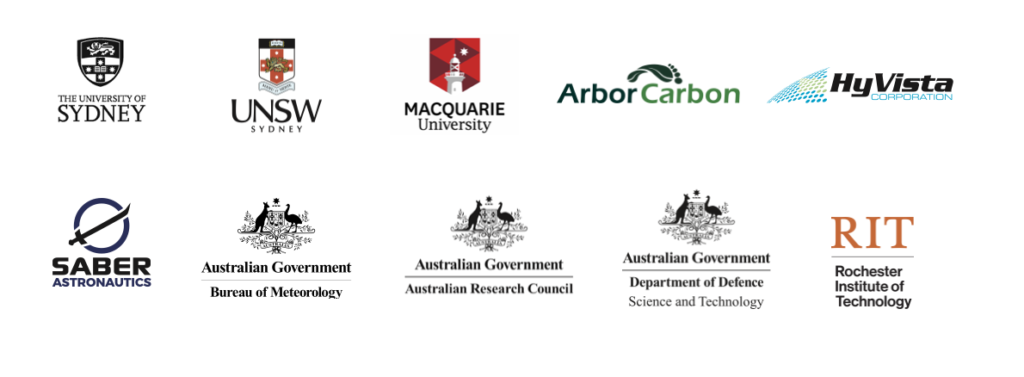CUAVA, the Australian Research Training Centre for CubeSats, UAVs and their Applications led by the University of Sydney, is pleased to announce the CUAVA-2 satellite has now been in orbit for over 110 days, completing over 1800 revolutions around the Earth.
Like its sister-satellite, Waratah Seed-1, the CUAVA-2 mission launched into orbit on 17 August 2024 (AEST) on the SpaceX Transporter 11 mission from Vandenberg Space Force Base. It was then successfully deployed approximately 515 kilometres above the Earth about 55 minutes after launch. Since its release from the rocket, CUAVA-2 has been orbiting at over 7 kilometres per second.
We established communications with CUAVA-2 during its first pass over Sydney, however unlike the WS-1 mission, CUAVA-2 experienced difficulties with the satellite’s first SD card failing around 5 days after launch, likely due to radiation from space weather. The satellite automatically booted its backup system and commissioning of the satellite is under way.
CUAVA-2 carries payloads produced by CUAVA’s academic research teams and university-based start-ups.
The payloads on board are:
- a GPS Reflectometry Receiver (Harry3), designed by a team from the Australian Centre for Space Engineering Research at the University of New South Wales (UNSW), to monitor ocean waves and land characteristics remotely by measuring GPS signals scattered from the Earth’s surfaces. The payload has strong potential for applications in shipping, off-shore oil rigs, sea-ice discrimination, and agriculture.
- a HyperSpectral Imager (HSI) designed and built at the University of Sydney’s School of Physics and SAIL Lab to capture images of marine and coastal environments at many wavelengths. These observations have many potential applications for agriculture, forestry, coastal and marine monitoring, and mineral exploration.
- an Electron Density and Debris instrument (EDDI), designed by a team from the University of Sydney’s Schools of Physics and Electrical Engineering to measure Earth’s plasma density and temperature by monitoring the electric field spectrum around the satellite. Changes in the ionosphere can disrupt the radio and GPS signals we rely on for navigation and communications systems on Earth. It can also detect hits by space debris on the satellite, allowing monitoring of space debris.
- a Radiation Counter and Data Over Power-Bus payload designed by a team from the University of Sydney’s School of Aerospace, Mechanical, and Mechatronic Engineering to measure variations in the energetic particles around the Earth and demonstrate the transmission of data over power channels rather than dedicated network cables.
- a Charge Exchange Thruster (CXT), invented and built by a team from the School of Physics at the University of Sydney, to demonstrate a prototype plasma thruster that can move small satellites in orbit using plumes of high-velocity neutral particles. The technology aims to address the shortage of electric propulsion systems on CubeSats; it is easy to manufacture and has potential as a commercial product.
- a Cross-reference of Stellar System (CROSS Star Tracker) designed by a student-led team from the University of Sydney to capture highly accurate satellite positioning data using images of known stars in a compact, cost-effective, and commercialisable payload for CubeSats.
- an ElectroPermanent Magnetorquer (EMP) designed by a team at the Schools of Aerospace, Mechanical and Mechatronic Engineering and Physics at the University of Sydney to demonstrate using magnetisation technology for changing a satellite’s spin and orientation, providing potential for a product which reduces the amount of energy required to stabilise satellites in orbit.
- a Perovskites in Orbit-Readiness Test (PORT) payload designed by EurokaPower, a startup led by 2024 Space Scientist of the Year Anita Ho-Baillie, and her team in the School of Physics at the University of Sydney. PORT is intended to demonstrate in space the capabilities of perovskite solar cells, high-efficiency, high-performance space-grade solar cells which can be manufactured at greatly reduced cost.
CUAVA-2 is an Australian-made and Australian-owned space system. It shows a capacity to serve the emerging Australian space sector and to grow Australia’s space capabilities and knowledge through researchers and students in CUAVA’s many partner organisations. The technical demonstration payloads on board address the needs of niche export markets in the international space sector.
The satellite is currently travelling at approximately 27,350km per hour and circles the earth around once an hour. You can follow the progress of the CUAVA-2 satellite in real-time on our website dashboard.






